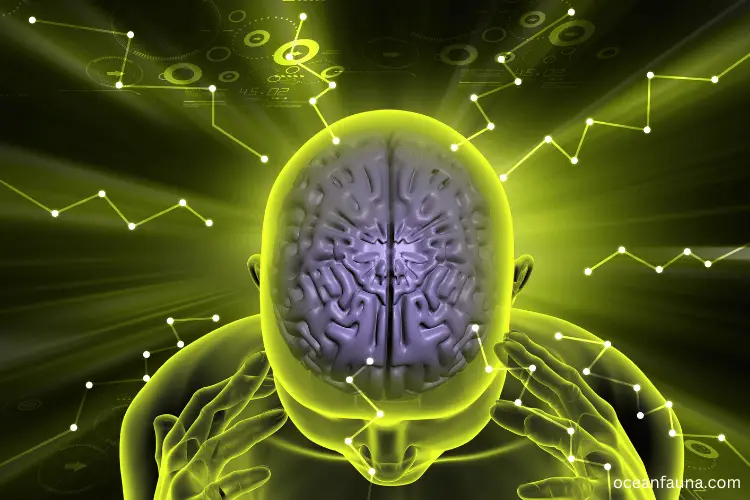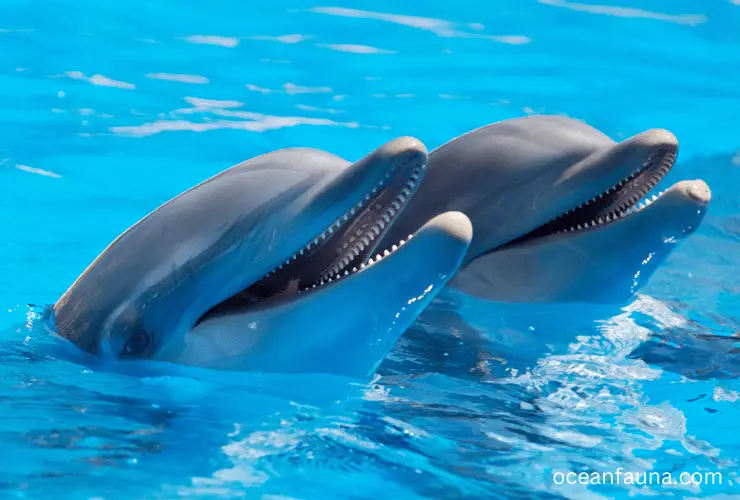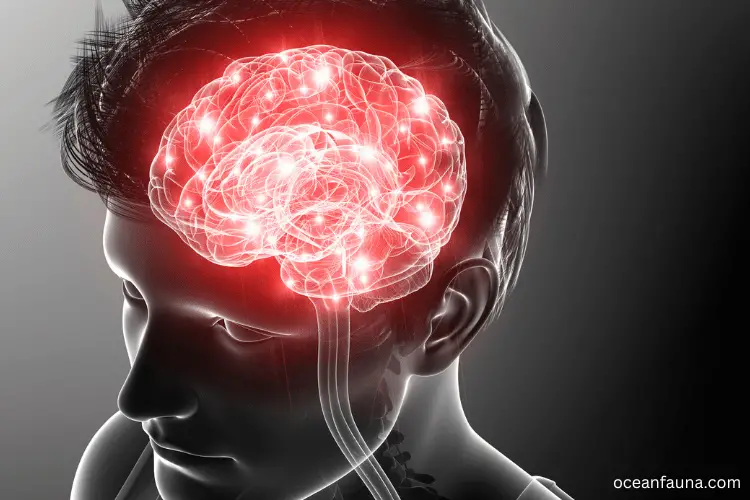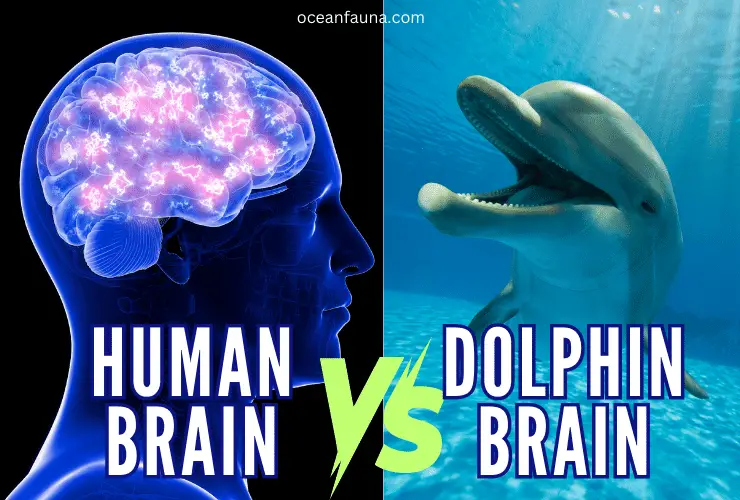While humans are known to be the smartest creature on earth, Dolphins are not too far behind. In the ocean environment, dolphins are the smartest. Compared to the human brain, the dolphin brain is surprisingly large and complex, with a few differences. So, what will be the comparative result of the dolphin brain vs the human brain?
In this article, I will discuss the differences in brain size, complexity and intelligence between dolphins and humans.
Dolphin Brain Vs Human Brain: Anatomical and Functional Comparison
Before you know all the differences in detail have a look at the chart.
| Aspect | Dolphin Brain | Human Brain |
| Relative size | Larger than human brain | Smaller than dolphin brain |
| Weight | 1600 Grams (Approx) | 1300 Grams (Approx) |
| Brain-to-body ratio | 1/50 | 1/40 |
| Encephalization quotient (EQ) | High EQ compared to other animals (4.2) | Highest EQ among all animals (7.0) |
| Brain structure | More convoluted and folded surface | Highly convoluted and folded surface |
| Brain hemispheres | Large and well-developed cerebral hemispheres | Dominant cerebral hemispheres responsible for language, logic, and complex tasks |
| Cerebral cortex | Have a more complex network of gyri and sulci in their brains, which results in greater encephalization than humans. Also, have 40 percent more cerebral cortex. | Large cerebral cortex with significant encephalization. |
| Brain function | Strongly associated with communication, social behavior, and echolocation | Linked to language, abstract thinking, and reasoning |
| Communication | Use sound and body language for communication | Primarily rely on language and facial expressions |
| Memory processing | Excellent long-term memory and memory for social structures | High capacity for memory and complex information processing |
| Self-awareness | Limited self-awareness | High level of self-awareness and introspection |
| Problem-solving | Demonstrates problem-solving abilities | High problem-solving capabilities and abstract reasoning |
Anatomical Comparison
The size of a brain is not primarily what determines its capacity for complex thinking and behaviour. However, it can indicate how much grey matter it holds and how many neurons it has available to work with.
Do you know the difference in weight between the dolphin brain and human brain? The dolphin brain (1600 grams) weighs 300 grams more than a human brain (1300 grams), yet it is structured differently with a larger cerebral cortex. Additionally, dolphin brains have a much smaller prefrontal cortex and hippocampus than humans.
The prefrontal cortex plays a key role in decision-making, impulse control, social behaviour, and personality expression in humans. In contrast, the prefrontal cortex in dolphins is comparatively smaller and less developed. This may be due to the fact that dolphins have a relatively limited range of social interactions and somewhat fixed behavioural patterns.

The hippocampus, on the other hand, is a small structure located deep in the brain’s temporal lobe responsible for memory formation and consolidation. In humans, it is a vital part of the brain that helps us remember important events, learn new skills, and navigate new environments.
In dolphins, the hippocampus is smaller and less complex than in humans, which might explain why they have a relatively limited capacity for learning new things.
Functional Comparison
Interestingly, research has shown that dolphins have exceptional cognitive abilities that are not necessarily related to their brain size or structure. They are highly social animals living in complex social groups, capable of sophisticated communication, problem-solving, and even cultural transmission.
Dolphins use a variety of sounds, body language, and touch to communicate with one another, and they are known for their ability to map complex acoustic environments using echolocation. This means that they can create mental maps of their surroundings using sound waves and then use that information to navigate and locate prey.
Dolphins also have been shown to have a remarkable memory capacity and can recognize familiar individuals after long periods of separation. They have been observed using tools and working collaboratively to solve problems, which indicates a high degree of advanced problem-solving intelligence.
Dolphin Brain Usage Percentage
It is well-known that dolphins have an incredibly advanced and complex brain, which is significantly larger than the human brain. Interestingly, dolphins can utilize 100% of their brain, while humans can use only a certain percentage of their brain capacity.
In fact, dolphins have a higher brain-to-body ratio than any other mammal on the planet, which suggests that they have superior cognitive ability as compared to humans.
The cognitive capabilities of dolphins are truly exceptional. Their brain has a complex pattern of grooves and folds that enable them to process a vast amount of information quickly and efficiently.
Additionally, the dolphin brain has a huge neocortex linked to advanced processing, emotional regulation, and the ability to learn and form complex relationships.
The high intelligence of dolphins is reflected in their behaviour and ability to interact with humans. They are known to exhibit a great range of emotions, including empathy, self-awareness, and social intelligence. Their intricate social structures, communication skills, and auditory perception also prove their advanced cognitive abilities.
Overall, the unique features of the dolphin brain allow them to fully utilize 100% of their cognitive potential, making them one of the most intelligent and sophisticated creatures on earth.
Human Brain Usage Percentage

Contrary to the myth, humans have the ability to use more than just 10% of their brains. Even some research says, sometimes humans use their brains at full potential, which is about 100%.
However, at any given time, humans may only be actively using a certain percentage of their brain capacity, depending on the activity or task at hand.
For example, if we are reading a book, we are using our visual processing centres, while listening to a lecture would utilize our auditory processing centres, and solving a math problem requires us to use our logic and reasoning centres.
In different situations, it is estimated that humans use about 50% of their brain capacity. But this percentage may increase or decrease depending on various factors such as age, sex, environment, and lifestyle.
Nevertheless, the human brain remains one of the most complex and adaptable organs in the body, with the ability to constantly change and develop as we learn, grow, and face new challenges.
Our brain is capable of incredible feats of cognition, such as creativity, problem-solving, and critical thinking. Humans have developed advanced language and communication skills, cultural traditions, and technological innovations, which showcase our cognitive abilities.
We can also reflect on our thoughts and experiences, develop empathy and emotional regulation, and make purposeful decisions based on our values and motivations.
Are Dolphins More Intelligent Than Humans?
No, dolphins are not more intelligent than humans. It is true that dolphins have long been considered one of the smartest animals on earth, with their impressive brain-to-body ratio and ability to use their brains more efficiently than many other species.

But when it comes to measuring intelligence, humans have developed a set of criteria designed to evaluate cognitive abilities in a way relevant to our own species.
Current tests for intelligence indicate that dolphins do not possess the same cognitive abilities as humans. For example, while dolphins are able to recognize themselves in mirrors and communicate with each other in complex ways, they do not have the same capacity for abstract reasoning and problem-solving as humans.
However, this does not necessarily mean that dolphins are less intelligent than humans overall. In fact, it is difficult to compare the intelligence of different species meaningfully.
Humans have evolved to be intelligent in ways that allow us to navigate our complex social and technological world, while dolphins have evolved to excel in their underwater environment.
Furthermore, many different types of intelligence can be measured, from emotional intelligence to spatial reasoning to creativity. Dolphins may excel in some areas of intelligence that humans do not, and vice versa.
Dolphin Brain Vs Human Brain: Difference in IQ & EQ
IQ (Intelligence Quotient) and EQ (Emotional Quotient) are two measures that have been developed to help understand the cognitive and emotional abilities of humans and animals. The difference in IQ and EQ between humans and dolphins is of great interest, as it can shed light on our understanding of animals’ intelligence and emotional capacities.
Difference in IQ between Dolphins and Human
Regarding IQ, humans are considered to be at the top of the animal kingdom. The average human IQ is 100, and most people fall within the range of 85-115. On the other hand, the average IQ of dolphins is estimated to be in the 80-90 range, which is lower than humans but still quite high for an animal. This difference in IQ can be attributed to several factors.
Firstly, humans have larger brain sizes and a more complex brain structure, which allows for more advanced cognitive abilities. Secondly, humans have developed advanced communication systems and cultural traditions, which have enabled us to pass on knowledge from one generation to the next. In contrast, dolphins have very limited cultural traditions and communication systems.
Difference in EQ between Dolphin and Human
Regarding EQ, the gap between humans and dolphins is much smaller. EQ is a measure of emotional intelligence, which includes the ability to understand and regulate one’s emotions and recognize and respond appropriately to the emotions of others.
Humans have an average EQ of 7.0, while dolphins have an EQ of 4.2, which is the closest EQ ratio to humans to any other animal.
This similarity in EQ can be attributed to the fact that dolphins have a highly social and complex social structure, which includes strong family bonds and the ability to form alliances with other dolphins.
Dolphins have empathized with distressed individuals and even helped each other in dangerous situations. These emotional capabilities suggest a level of intelligence and awareness that is comparable to humans.
Is a Dolphin Brain More Complex Than a Human Brain?

While the dolphin’s brain is undoubtedly impressive, it cannot be deemed outright more complex than the human brain. The complex nature of the brain is multifaceted and cannot simply be evaluated through one aspect or characteristic.
The dolphin brain is larger than the human brain, weighing in at an average of 1,300 grams compared to the dolphin’s 1,600. However, this is not the only measure of complexity and does not necessarily indicate superiority.
In fact, the cerebral cortex of a dolphin’s brain contains 40% more neurons than that of a human brain, which does suggest a greater level of complexity.
Moreover, while the dolphin’s cerebellar hemispheres are larger than those of humans, and their echolocation system is more complex, these features alone do not make for a more complex brain overall.
The human brain, for example, is responsible for complex cognitive processes such as language, abstract reasoning, and decision-making, abilities that have not yet been observed in dolphins.
However, there are still many unknowns regarding the dolphin brain. Research has shown that dolphins have incredible social intelligence and may have complex emotional lives, but the extent to which their brain governs these remains to be fully understood.
Does a Dolphin’s Brain Have More Neurons Brain Than a Human’s?
Yes, dolphins have more neurons in their brain than humans do. Specifically, the dolphin species examined in the study had more neocortical neurons than any mammal studied so far, including humans.
The neocortex is the part of the brain involved in higher cognitive functioning, such as conscious thought, language, and spatial reasoning. It is often considered the most advanced part of the mammalian brain, and humans are known for having an especially large and complex neocortex compared to other animals.
However, the neocortex is not the only part of the brain responsible for intelligence and cognitive ability. The limbic cortex, which was mentioned in the background context as having 13,000 neurons/mm3 in dolphins, is also important for processing emotions and memory.
The cerebellum, which controls movement and coordination, is another brain region with a high concentration of neurons.
When comparing the number of neurons in different species, it’s important to consider the size of the brain as well. The human brain weighs approximately 1.3 kg, while the brain of a bottlenose dolphin weighs around 1.6 kg. This means that, on average, a dolphin brain is slightly larger than a human brain.
However, the specific species of dolphin examined in the study may have a larger or smaller brain than average, so it’s important to remember this.
To better understand the relative number of neurons in a dolphin brain versus a human brain, we can look at some rough comparisons. According to one estimate, the human neocortex contains approximately 16 billion neurons. This is a much larger number than the 13,000 neurons/mm3 found in the dolphin limbic cortex, but the neocortex is only one part of the brain.
Considering all the other areas of the brain with high neuron density, such as the cerebellum, the total number of neurons in the human brain is estimated to be around 86 billion.
Conclusion
Hopefully, you have a deep understanding of the dolphin brain and the human brain. Although the size of a dolphin’s brain is bigger, in the case of smartness, humans are always ahead of dolphins. If you have more queries, let me know.

